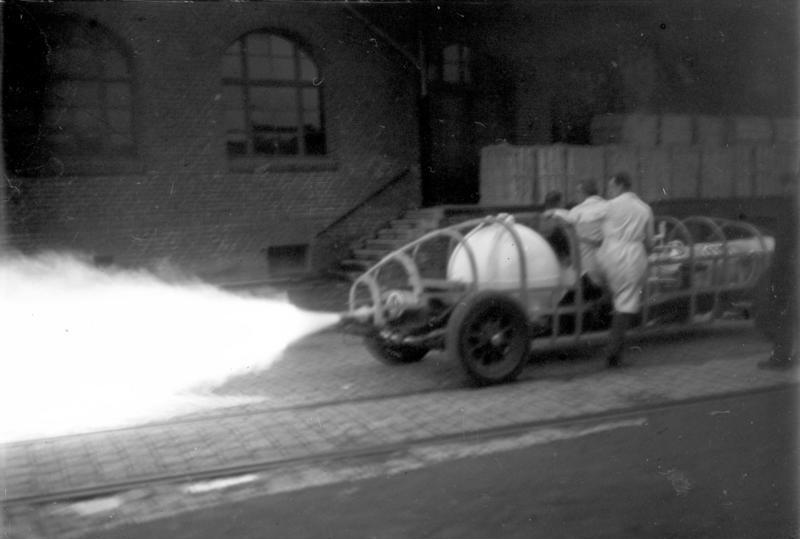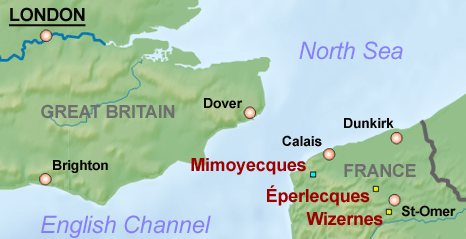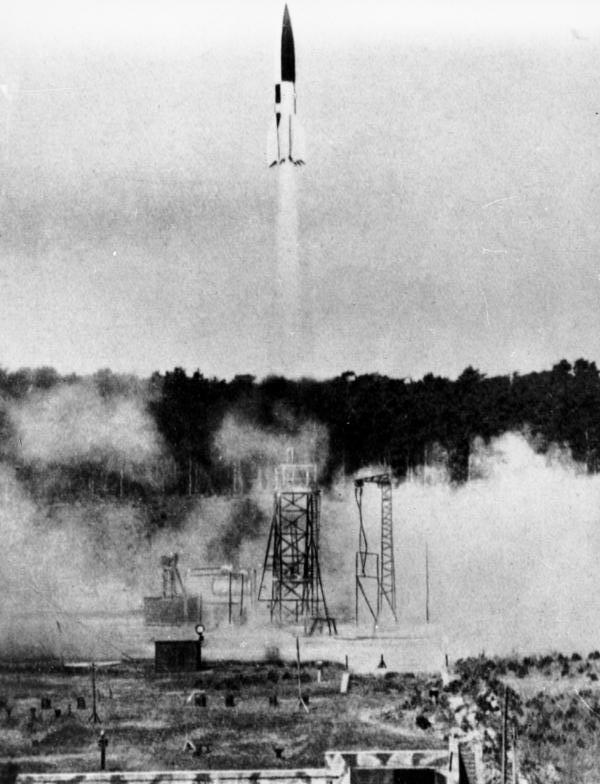|
Mittelwerk
Mittelwerk (; German for "Central Works") was a German World War II factory built underground in the Kohnstein to avoid Allied bombing. It used slave labor from the Mittelbau-Dora concentration camp to produce V-2 ballistic missiles, V-1 flying bombs, and other weapons. Mittelwerk GmbH On the night of 17/18 August 1943, RAF bombers carried out Operation Hydra against the Peenemünde Army Research Center where V-2 development and production was being carried out. On 19 October 1943, the German limited company Mittelwerk GmbH was issued War Contract No. 0011-5565/43 by General Emil Leeb, head of the Army Weapons Office, for 12,000 A-4 missiles at 40,000 Reichsmarks each. Mittelwerk GmbH also headed sites for V-2 rocket development and testing at Schlier (Project Zement) and Lehesten. Beginning in May 1944, Georg Rickhey was the Mittelwerk general manager, Albin Sawatzki was the Mittelwerk technical director over both Arthur Rudolph's Technical Division (with deputy Karl Sei ... [...More Info...] [...Related Items...] OR: [Wikipedia] [Google] [Baidu] |
Magnus Von Braun
Magnus "Mac" Freiherr von Braun (10 May 1919 – 21 June 2003) was a German chemical engineer, Luftwaffe aviator, rocket scientist and business executive. In his 20s he worked as a rocket scientist at Peenemünde and the Mittelwerk. At age 26, he emigrated to the United States via Operation Paperclip, where he worked for some years at Fort Bliss. In 1955 he began a career as a senior executive with Chrysler's missile and later automotive divisions, retiring in 1975. He lived for 58 years partially in the United States and partially in the United Kingdom until his death. He was the brother of Sigismund and Wernher von Braun. Biography Von Braun was born in Greifswald, Pomerania, to Magnus Freiherr von Braun and Emmy von Quistorp. After completing boarding school at Hermann Lietz-Schule in Spiekeroog, he began his studies in 1937 at Technische Universität München. There he remained after receiving his master's degree in organic chemistry, and became an assistant to Nobel lau ... [...More Info...] [...Related Items...] OR: [Wikipedia] [Google] [Baidu] |
Arthur Rudolph
Arthur Louis Hugo Rudolph (November 9, 1906 – January 1, 1996) was a German rocket engineer who was a leader of the effort to develop the V-2 rocket for Nazi Germany. After World War II, the United States Government's Office of Strategic Services (OSS) brought him to the U.S. as part of the clandestine Operation Paperclip, where he became one of the main developers of the U.S. space program. He worked within the U.S. Army and NASA, where he managed the development of several systems, including the Pershing missile and the Saturn V Moon rocket. In 1984, the U.S. Government investigated him for war crimes, and he agreed to renounce his United States citizenship and leave the U.S. in return for not being prosecuted. Early life Rudolph was born in Stepfershausen, Meiningen, Germany in 1906. His family were farmers, with a long tradition in the area. His father Gustav died in 1915 while serving in World War I. Arthur and his younger brother Walter were raised by their mothe ... [...More Info...] [...Related Items...] OR: [Wikipedia] [Google] [Baidu] |
Mittelbau-Dora
Mittelbau-Dora (also Dora-Mittelbau and Nordhausen-Dora) was a Nazi concentration camp located near Nordhausen in Thuringia, Germany. It was established in late summer 1943 as a subcamp of Buchenwald concentration camp, supplying slave labour from many Eastern countries occupied by Germany (including evacuated survivors of eastern extermination camps), for extending the nearby tunnels in the Kohnstein and for manufacturing the V-2 rocket and the V-1 flying bomb. In the summer of 1944, ''Mittelbau'' became an independent concentration camp with numerous subcamps of its own. In 1945, most of the surviving inmates were sent on death marches or crammed in trains of box-cars by the SS. On 11 April 1945, US troops freed the remaining prisoners. The inmates at Dora-Mittelbau were treated in a brutal and inhumane manner, working 14-hour days and being denied access to basic hygiene, beds, and adequate rations. Around one in three of the roughly 60,000 prisoners who were sent to Dora-M ... [...More Info...] [...Related Items...] OR: [Wikipedia] [Google] [Baidu] |
Kohnstein
The Kohnstein is a hill in Thuringia, Germany, 2 kilometres southwest of the village of Niedersachswerfen and 3 kilometres northwest of the centre of the town of Nordhausen. Gypsum mining created tunnels in the hill that were later used as a fuel/chemical depot and for Nazi Germany factories, including the Mittelwerk V-2 rocket factory that used Mittelbau-Dora slave labour. Chronology 1917–1934: The Badische Anilin- und Soda-Fabrik (BASF) purchased the property and mined anhydrite for gypsum. 1935 summer: At the suggestion of IG Farben, the '' Wirtschaftliche Forschungsgesellschaft (WIFO)'' ( en, Economic Research Company) investigated the mine to centralize a fuel and chemical depot. 1936: Wifo took over the mines to create a highly secret central petroleum reserve. The Government's ''Industrial Research Association'' invested some effort in adapting the tunnels and galleries for the storage of critical chemicals like tetra-ethyl-lead (petroleum anti-knock). 1937–1 ... [...More Info...] [...Related Items...] OR: [Wikipedia] [Google] [Baidu] |
Redl-Zipf
The Redl-Zipf V-2 rocket facility (code name ''Schlier'') located in central Austria between Vöcklabruck and Vöcklamarkt and established in September 1943 began operation for V-2 rocket motor testing after Raxwerke test equipment had been moved from Friedrichshafen. The facility tested V-2 combustion chambers' compatibility with turbopumps since the rocket did not have a controller for reducing the turbopumping of propellant into the chamber if pressure became too high. The World War II facility used as a starting base the cellars and storage tunnels of an old brewery. Construction of the facility was under the command of SS-Obergruppenführer Hans Kammler who was responsible for Nazi civil engineering projects and its top secret weapons programs and used forced labor from the Schlier-Redl-Zipf subcamp of the Mauthausen-Gusen concentration camp. The construction added a large number of tunnels and supporting structures and included a liquid oxygen generation plant in one of th ... [...More Info...] [...Related Items...] OR: [Wikipedia] [Google] [Baidu] |
Heinkel He 162
The Heinkel He 162 ''Volksjäger'' (German language, German, "People's Fighter") was a German single-engine, jet-powered fighter aircraft fielded by the Luftwaffe in World War II. Developed under the Emergency Fighter Program, it was designed and built quickly and made primarily of wood as metals were in very short supply and prioritised for other aircraft. ''Volksjäger'' was the Reich Air Ministry's official name for the government design program competition won by the He 162 design. Other names given to the plane include ''Salamander'', which was the codename of its wing-construction program, and ''Spatz'' ("Sparrow"), which was the name given to the plane by the Heinkel aviation firm. The aircraft was notable for its small size; although almost the same length as a Messerschmitt Bf 109, Bf 109, its wing was much shorter at vs. for the 109. Most distinctive was its top-mounted engine, which combined with the aircraft's ground-hugging landing gear allowed the engine to ... [...More Info...] [...Related Items...] OR: [Wikipedia] [Google] [Baidu] |
Peenemünde Army Research Center
The Peenemünde Army Research Center (german: Heeresversuchsanstalt Peenemünde, HVP) was founded in 1937 as one of five military proving grounds under the German Army Weapons Office (''Heereswaffenamt''). Several German guided missiles and rockets of World War II were developed by the HVP, including the V-2 rocket. The works were attacked by the British in Operation Crossbow from August 1943, before falling to the Soviets in May 1945. History On April 2, 1936, the aviation ministry paid 750,000 reichsmarks to the town of Wolgast for the whole Northern peninsula of the Baltic island of Usedom. By the middle of 1938, the Army facility had been separated from the Luftwaffe facility and was nearly complete, with personnel moved from Kummersdorf. The Army Research Center (''Peenemünde Ost'') consisted of ''Werk Ost'' and ''Werk Süd'', while ''Werk West'' (Peenemünde West) was the Luftwaffe Test Site (), one of the four test and research facilities of the Luftwaffe, with ... [...More Info...] [...Related Items...] OR: [Wikipedia] [Google] [Baidu] |
Nordhausen, Thuringia
Nordhausen () is a city in Thuringia, Germany. It is the capital of the Nordhausen district and the urban centre of northern Thuringia and the southern Harz region; its population is 42,000. Nordhausen is located approximately north of Erfurt, west of Halle, south of Braunschweig and east of Göttingen. Nordhausen was first mentioned in records in the year 927 and became one of the most important cities in central Germany during the later Middle Ages. The city is situated on the Zorge river, a tributary of the Helme within the fertile region of Goldene Aue ''(golden floodplain)'' at the southern edge of the Harz mountains. In the early 13th century, it became a free imperial city, so that it was an independent and republican self-ruled member of the Holy Roman Empire. Due to its long-distance trade, Nordhausen was prosperous and influential, with a population of 8,000 around 1500. It was the third-largest city in Thuringia after Erfurt, today's capital, and Mühlhausen, ... [...More Info...] [...Related Items...] OR: [Wikipedia] [Google] [Baidu] |
Blockhaus D'Éperlecques
The ''Blockhaus d'Éperlecques'' ( en, Bunker of Éperlecques, also referred to as "the Watten bunker" or simply "Watten") is a Second World War bunker, now part of a museum, near Saint-Omer in the northern Pas-de-Calais ''département'' of France, and only some 14.4 kilometers (8.9 miles) north-northwest from the more developed La Coupole V-2 launch facility, in the same general area. The bunker, built by Nazi Germany under the codename Kraftwerk Nord West (Powerplant Northwest) between March 1943 and July 1944, was originally intended to be a launching facility for the V-2 (A-4) ballistic missile. It was designed to accommodate over 100 missiles at a time and to launch up to 36 daily. The facility would have incorporated a liquid oxygen factory and a bomb-proof train station to allow missiles and supplies to be delivered from production facilities in Germany. It was constructed using the labour of thousands of prisoners of war and forcibly conscripted workers used as slave ... [...More Info...] [...Related Items...] OR: [Wikipedia] [Google] [Baidu] |
Hans Kammler
Hans Kammler (26 August 1901 – 1945 ssumed was an SS-Obergruppenführer responsible for Nazi civil engineering projects and its top secret weapons programmes. He oversaw the construction of various Nazi concentration camps before being put in charge of the V-2 rocket and jet programmes towards the end of World War II. Kammler disappeared in May 1945, during the final days of the war. There has been much conjecture regarding his fate. Early life Kammler was born in Stettin, German Empire (now Szczecin, Poland). In 1919, after volunteering for army service, he served in the Rossbach Freikorps. From 1919 to 1923, he studied civil engineering at the Technische Hochschule der Freien Stadt Danzig and Munich and was awarded his doctorate of engineering (Dr. Ing.) in November 1932, following some years of practical work in local building administration. Nazi party In 1931, Kammler joined the Nazi Party (NSDAP), where he held a variety of administrative positions after the Nazi g ... [...More Info...] [...Related Items...] OR: [Wikipedia] [Google] [Baidu] |
The Linde Group
Linde plc is a global multinational chemical company founded in Germany and, since 2018, domiciled in Ireland and headquartered in the United Kingdom. Linde is the world's largest industrial gas company by market share and revenue. It serves customers in the healthcare, petroleum refining, manufacturing, food, beverage carbonation, fiber-optics, steel making, aerospace, material handling equipment (MHE), chemicals, electronics and water treatment industries. The company's primary business is the manufacturing and distribution of atmospheric gases, including oxygen, nitrogen, argon, rare gases, and process gases, including carbon dioxide, helium, hydrogen, ammonia, electronic gases, specialty gases, and acetylene. The company was formed by the 2018 merger of Linde AG of Germany (founded in 1879) and Praxair (founded in 1907 as Linde Air Products Company) of the United States. The resulting holding company was incorporated in Ireland, with principal executive offices in Guildfor ... [...More Info...] [...Related Items...] OR: [Wikipedia] [Google] [Baidu] |
V-1 Flying Bomb
The V-1 flying bomb (german: Vergeltungswaffe 1 "Vengeance Weapon 1") was an early cruise missile. Its official Ministry of Aviation (Nazi Germany), Reich Aviation Ministry () designation was Fi 103. It was also known to the Allies as the buzz bomb or doodlebug and in Germany as (cherry stone) or (maybug). The V-1 was the first of the (V-weapons) deployed for the terror bombing of London. It was developed at Peenemünde Army Research Center in 1939 by the at the beginning of the Second World War, and during initial development was known by the codename "Cherry Stone". Because of its limited range, the thousands of V-1 missiles launched into England were fired from V-1 flying bomb facilities, launch facilities along the French (Pas-de-Calais) and Dutch coasts. The Wehrmacht first launched the V-1s against London on 13 June 1944, one week after (and prompted by) the successful Operation Overlord, Allied landings in France. At peak, more than one hundred V-1s a day were fire ... [...More Info...] [...Related Items...] OR: [Wikipedia] [Google] [Baidu] |











